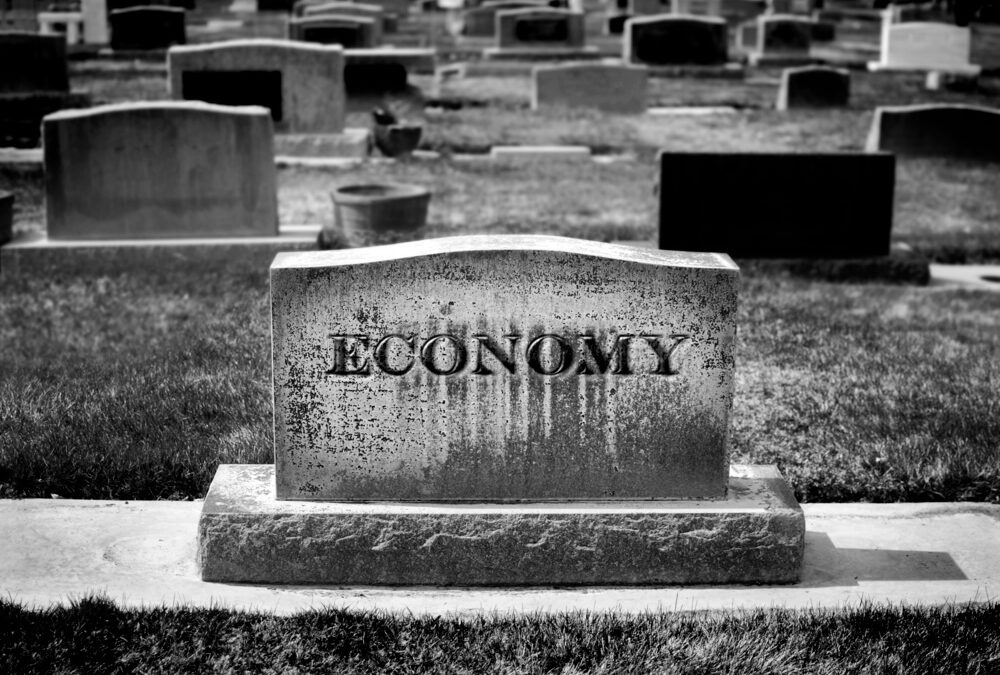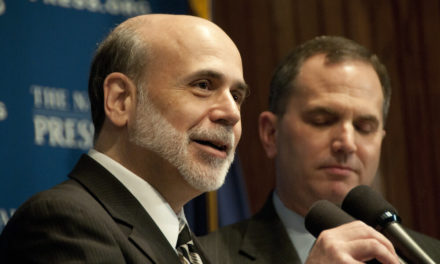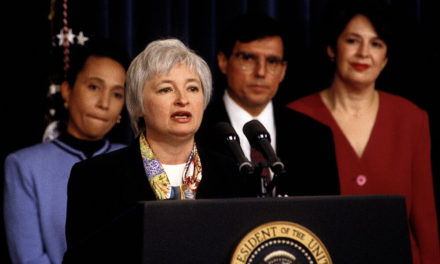It’s no secret that even those most well-versed in the market and economy can’t predict when or even why an economic expansion dies. There are theories, of course, most of which contradict one other and none of which are fully supported by data. And because no one really knows why recessions start, they also can’t predict when one will start.
What we do know is that economic growth is fueled by the confidence of consumers, businesses and investors and lately, that confidence has been sagging.
Per Bloomberg:
It seems like a strange time for anyone to worry about a recession. On Jan. 4 the Bureau of Labor Statistics reported that the U.S. economy created 312,000 jobs in December, half again as much as the monthly average over the past five years. Ordinarily such a burst of hiring would drive down the unemployment rate, which has stayed below 4 percent for the longest period since the Soaring Sixties. The only reason it actually rose a bit—two ticks, to 3.9 percent—is that the hot pace of hiring drew more people into the labor force. That’s exactly what you want to see: discouraged workers, premature retirees, and people out on disability all giving the job market another try.
It’s not just the job market that’s booming. GDP grew at a 4.2 percent annual rate in the second quarter of 2018 and 3.4 percent in the third, and it’s estimated by economists surveyed by Bloomberg to have grown 2.6 percent in the just-ended fourth quarter. Those are good numbers when you consider that based on population and productivity trends, the Fed estimates that the U.S. economy’s long-run growth potential is only around 1.9 percent a year.
Despite that, investors don’t share Kudlow’s confidence. That’s seen most clearly in the stock market, where the S&P 500 is down 11 percent over the past three months. Inflation expectations have fallen, a sign of lack of confidence in economic growth. The Business Roundtable’s index of the economic outlook of big-company chief executives, while still above its long-run average, has fallen for three straight quarters.
Consumers are the one group that remains solidly confident, maybe because the share of Americans surveyed by the Conference Board who say jobs are hard to get is the lowest in 18 years. Holiday spending was strong. But even consumers have their limits. Auto sales have been flat since 2015. REV Group Inc. of Milwaukee, which makes recreational vehicles, saw its stock plunge 77 percent in 2018, in part because of a drop in sales, especially of its most expensive RVs. It’s worth bearing in mind that a lot of consumers are investors, too, so their stock portfolios matter to them along with their salaries.
A big reason for the jitters is most think expansions die of old age.
They think good times lead inevitably to excess: Companies overproduce, consumers overspend, and balance has to be restored. In the debt cycle theory of the late American economist Hyman Minsky, a theorist of financial fragility, easy lending leads to foolish investments, which lead to defaults and a sharp drop in lending that kills growth.
And if the current expansion doesn’t die of old age, it could be murdered — by the Federal Reserve.
The Fed has raised interest rates nine times since the end of 2015 to slow loan growth and keep the economy from overheating, which would push inflation above its 2 percent target. One sign of possible overheating is that average hourly earnings in retail trade have jumped 5 percent from a year ago, Torsten Slok, chief international economist at Deutsche Bank Securities Inc., wrote in a Jan. 7 note. Although broader measures of worker pay are up less than that, wage inflation is “one issue we continue to worry about,” he wrote.
The risk is that in trying to restrain inflation, the Fed will overdo it and choke off the very expansion it’s working so hard to sustain. Stocks plunged after a meeting on Dec. 19 at which Fed policymakers indicated that they saw two more rate hikes coming this year.
The killer-Fed theory lost some of its cogency on Jan. 4, and stocks soared, when Fed Chairman Jay Powell, who was seated with former Chairs Janet Yellen and Ben Bernanke, said he felt inflation was under control and assured investors that the central bank would be patient in raising rates. “Right now there is nobody hiding behind the curtain” to kill the recovery, Goldman Sachs & Co. Chief Economist Jan Hatzius wrote in a Jan. 7 client note that picked up on Bernanke’s Agatha Christie theme.
If not the Fed, maybe China will trigger a U.S. recession? The concern is that the Chinese economy is slowing abruptly. Gauges of China’s manufacturing sector point toward contraction, and the Shanghai Composite Index of stocks just hit a four-year low. One factor in the slowdown is the trade war with the U.S., which could heat up again when a 90-day truce expires in March. But it’s a stretch to argue that trouble in China will make serious problems for the U.S. outside of a few companies that rely heavily on that market for sales, such as Apple Inc. Assuming China’s troubles don’t cause a financial crisis, the U.S. could even benefit if a slowdown there leads to lower global interest rates and oil prices, says Michael Englund, chief economist of Action Economics LLC in Boulder, Colo.
The stalemate over a wall on the Mexican border is another trouble spot that could presage more damaging confrontations between the Trump White House and the Democrats who control the House of Representatives. Congress agreed last year to reinstate the federal debt ceiling on March 2 of this year. The U.S. Department of the Treasury has ways to postpone hitting the ceiling, but Congress and President Trump will have to lift it by around September to prevent a default or shutdown. “The signaling effects of a US Government default would be horrible and profound,” Michael Cloherty, head of U.S. rates strategy at RBC Capital Markets, wrote in a Jan. 8 note.
Any theory of where we are in the business cycle has to be able to explain why financial markets are weakening even as the economy is rapidly generating jobs, says Robert Hall, an economist who’s chairman of the Committee on Business Cycle Dating, an arm of the private National Bureau of Economic Research that determines, after the fact, when a recession began and when it ended. Ordinarily, he says, a darkening of the mood that drove down stocks would also lower investment and hiring by businesses. That’s what happened the last time recession struck, in December 2007.
Hall is a senior fellow at Stanford’s Hoover Institution and a professor at the university. To him, today’s situation is reminiscent of the stock market crash of October 1987, which produced the worst-ever day for stocks. Now as then, stocks fell sharply even though the underlying economy was healthy. The 1987 crash was blamed in part on portfolio insurance, a product that was supposed to protect investors from losses but ended up accelerating the downturn by causing investors to sell into a falling market. Some of the algorithmic trading driving today’s market volatility has the same characteristic of selling, instead of buying, when shares become cheaper.
For professional reasons, Hall doesn’t try to predict recessions. He says he fears that would create a conflict in the deliberations of the committee he chairs. What he will say is that expansions rarely end without warning. “Generally there is a period of red flags flying,” he says.
Unless, of course, you think we’re already in a recession. In November 2015, 72 percent of Americans surveyed by the Public Religion Research Institute said the country was in one, even though Hall’s committee had concluded that it ended in 2009. One reason for the dissonance is that cycle daters define a recession in an unintuitive way. They define it as a decline in the economy, not a low level of economic activity. Specifically, they say it is “a significant decline in economic activity spread across the economy, lasting more than a few months, normally visible in real GDP, real income, employment, industrial production, and wholesale-retail sales.”
So even if things are really bad, but they’ve stopped getting worse, the recession is over. Conversely, if they’re really good but they’ve stopped getting better, the expansion is over and a recession has set in. How the public perceives the economy isn’t in the equation.
While sentiment doesn’t appear in the technical definition of a recession, it can be the invisible force that drives the economy down. Investors play a key role in that process, which is why the market’s recent slide is dangerous even if the pessimism is overdone. If investors see trouble for the market in the future, they’ll sell now to get out before prices fall. By pushing down stock prices and pushing up interest rates, they make it harder for companies to raise money by selling shares or floating bonds. As a result, they can accelerate the downturn they were worried about.
That’s tantamount to murder, or at least involuntary manslaughter. “Economists might confidently predict that the end of the cycle is coming next year, not this,” Tom Orlik, the chief economist of Bloomberg Economics, wrote in a Jan. 7 email. “But if markets start pricing that in today, and tighter financial conditions start to hit activity in the real economy, the downturn could arrive earlier than expected.”




